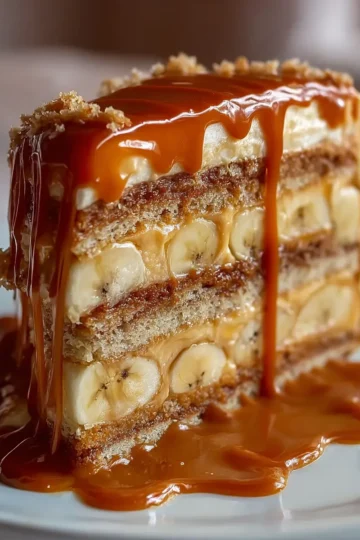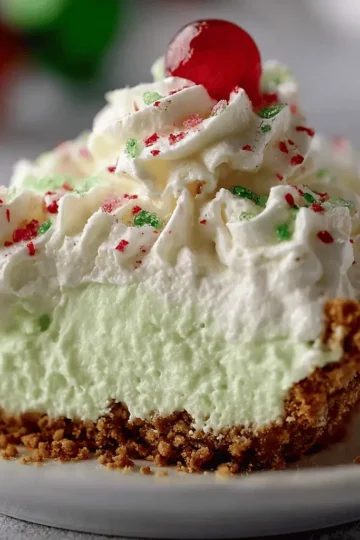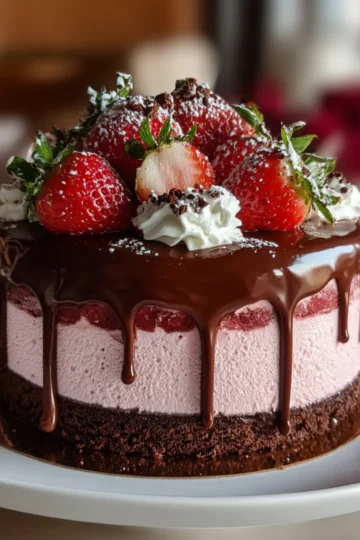Introduction
Savory cheesecakes are redefining the boundaries of traditional dessert, offering a rich, indulgent experience that’s more than just sweet. With a surge in culinary creativity, chefs and home cooks alike are exploring how vegetables can be seamlessly blended into desserts, giving rise to bold and unexpected flavor combinations. One standout creation is the Beetroot Feta Cheesecake with Dill and Pistachio Dust—a stunning, velvety dish that delights the palate and the eye.
This vibrant cheesecake combines the earthy sweetness of beetroot with the tangy creaminess of feta, the fresh herbal notes of dill, and the nutty crunch of pistachios. It’s not just a feast for your taste buds—it’s a wholesome, nutrient-packed treat.
Packed with antioxidants, protein, and healthy fats, this savory cheesecake also delivers a unique balance of flavors and textures—making it perfect for brunches, garden parties, or as a showstopping appetizer.
The Rise of Savory Cheesecakes
Traditionally, cheesecakes have been associated with sugary indulgence, from New York-style to fruity variations. However, the culinary world has seen a delicious shift—savory cheesecakes are gaining momentum, driven by a desire for more complex, umami-rich flavor experiences. This evolution reflects the growing appreciation for dishes that blur the lines between savory and sweet.
Around the globe, different cuisines have embraced this trend. In France, chèvre-based cheesecakes with herbs have long graced gourmet tables. In the Mediterranean, cheeses like feta and ricotta are frequently paired with savory elements, creating rich and satisfying dishes. These variations aren’t just palate-pleasers—they’re reflections of regional ingredients and traditions.
Even celebrity chefs are leaning into the trend. For example, Ottolenghi’s signature dishes often highlight vegetable-forward, savory creations that celebrate natural flavors. Similarly, restaurants like The Cheesecake Factory have toyed with seasonal savory specials that spotlight nontraditional ingredients. This modern twist on an old classic is carving out its own niche in today’s gourmet kitchens, proving that cheesecake isn’t just for dessert anymore.
Spotlight on Key Ingredients
Beetroot
- Beetroot is a powerhouse of nutrients, known for its vibrant color and sweet, earthy flavor.
- It’s rich in antioxidants, vitamin C, and fiber, which support heart health and reduce inflammation.
- In the kitchen, beetroot is incredibly versatile—used in soups, salads, and even smoothies. Its natural sweetness and vivid color make it ideal for baking, especially in recipes like this savory cheesecake.
- According to Healthline, beetroot may also help lower blood pressure and boost stamina.
Feta Cheese
- Originating from Greece, feta cheese is known for its tangy, salty flavor and crumbly texture.
- It’s typically made from sheep’s milk, and sometimes goat’s milk, giving it a distinct richness.
- Feta is low in calories but high in calcium, protein, and vitamin B12, making it a great choice for adding flavor and nutrition.
- This cheese blends beautifully with sweet vegetables like beetroot, balancing sweetness with a sharp, creamy bite.
Dill
- With its bright green fronds and delicate, anise-like flavor, dill is a favorite in Scandinavian and Eastern European cooking.
- It enhances dishes with its fresh, citrusy aroma and pairs exceptionally well with dairy, making it a perfect match for feta and yogurt.
- Dill also offers digestive benefits and contains compounds that may help regulate blood sugar and cholesterol levels.
Pistachios
- Pistachios are not just a flavorful topping—they bring texture, color, and a nutritional punch to this dish.
- These nuts are loaded with healthy fats, protein, and essential minerals like potassium and magnesium.
- Their mildly sweet, nutty taste complements the savory cheesecake beautifully, while the crunch contrasts the smooth filling.
- Crushed into a fine dust, they create a beautiful finishing touch that’s both decorative and delicious.
Recipe Overview
The Beetroot Feta Cheesecake with Dill and Pistachio Dust is a bold twist on traditional cheesecake, transforming a sweet favorite into a savory masterpiece. Combining the earthy tones of beetroot with the tang of feta cheese, the brightness of fresh dill, and the crunch of pistachio, this recipe is a vibrant, nutritious dish that delights the senses. Perfect for brunches, dinner parties, or appetizer platters, it delivers an unexpected yet deeply satisfying experience.
This cheesecake’s unique flavor profile appeals to adventurous food lovers looking to experiment with vegetables in elegant, unconventional ways. The creamy filling is both light and rich, with zesty lemon lifting the flavors, while the pistachio dust offers a satisfying contrast in texture. Whether served cool or at room temperature, this savory cheesecake is guaranteed to turn heads and start conversations.
Detailed Ingredients List and Substitutions
For the Cheesecake
- 7 oz (200g) cooked beetroot, blended until smooth (boiled or roasted)
Substitute: roasted carrots or sweet potato for a different flavor - 7 oz (200g) feta cheese, crumbled
Substitute: vegan feta or cashew cheese for dairy-free option - 3.5 oz (100g) Greek yogurt or cream cheese
Substitute: plant-based yogurt or vegan cream cheese - 3 large eggs
Substitute: flax eggs (1 tablespoon ground flax + 3 tablespoon water per egg) - 1 tablespoon lemon juice
- Zest of ½ lemon
- 1 tablespoon fresh dill, finely chopped
- A pinch of black pepper
- Salt, only if needed
For the Pistachio Dust
- ¼ cup roasted pistachios, ground finely
Substitute: sunflower seeds or roasted almonds for nut-free option
According to The Telegraph, nuts like pistachios add a protein-packed crunch to vegetarian dishes.
Optional Garnishes
- Extra fresh dill, chopped
- Lemon zest
- Drizzle of olive oil
For presentation ideas, see Foodies Magazine or Susanna’s To Go for visual inspiration.
Step-by-Step Preparation Guide
Preparing the Cheesecake Mixture
Start by preheating your oven to 350°F (175°C) and greasing an 8-inch springform pan. Line the bottom with parchment paper for easy removal. In a blender or food processor, combine the smooth beetroot purée, feta cheese, Greek yogurt, eggs, lemon juice, lemon zest, chopped dill, black pepper, and a touch of salt if needed. Blend until the mixture is silky smooth and fully integrated.
Baking the Cheesecake
Pour the blended mixture into the prepared pan and smooth the surface with a spatula. Bake for 30–35 minutes, or until the edges are firm and the center is still slightly jiggly. To prevent cracking, avoid overbaking and do not open the oven door during the first 25 minutes. Let the cheesecake cool gradually by turning off the oven and keeping the door slightly ajar.
Cooling and Chilling
Once the cheesecake has cooled to room temperature, transfer it to the refrigerator. Chill for at least 2–3 hours to allow it to firm up completely. This step is essential for achieving that creamy, sliceable texture and letting the flavors meld.
Preparing the Pistachio Dust
Using a mortar and pestle or food processor, grind the roasted pistachios into a fine crumb. Don’t over-process, or it will become pistachio butter. A Copy Me That kitchen tip recommends pulsing in short bursts for better control.
Garnishing and Serving
Remove the cheesecake from the pan. Sprinkle generously with pistachio dust, and garnish with extra dill, a bit more lemon zest, and a light drizzle of olive oil for added richness. Serve cool or at room temperature with crusty bread or fresh greens for a complete dish.
Pairing Suggestions for Beetroot Feta Cheesecake with Dill and Pistachio Dust
Beverage Pairings
Pairing the Beetroot Feta Cheesecake with Dill and Pistachio Dust with the right beverage elevates the flavor experience. For wine lovers, a dry rosé or crisp Sauvignon Blanc balances the creamy texture and herbaceous notes. A light Pinot Noir also complements the earthy beetroot and salty feta beautifully. If you prefer non-alcoholic options, a chilled cucumber-mint lemonade or a mild green tea brings refreshing contrast and enhances the dish’s herbal profile.
According to The Telegraph, pairing herbal or lightly fruity drinks with vegetable-forward dishes can enhance complexity without overpowering the palate.
Side Dishes
This savory cheesecake shines when accompanied by light and refreshing side dishes. Consider a citrus-dressed arugula salad with shaved fennel or a cucumber-dill yogurt dip served with grilled pita. Roasted baby carrots with lemon zest or a chilled lentil salad with parsley and mint make satisfying additions. These sides not only add balance but also reinforce the fresh, vibrant character of the dish.
Nutritional Information
Each serving of Beetroot Feta Cheesecake with Dill and Pistachio Dust contains approximately 220 kcal. This dish is nutrient-dense, offering a good balance of proteins, healthy fats, and complex carbohydrates. The inclusion of feta and Greek yogurt provides a generous dose of calcium, B vitamins, and protein, supporting bone and muscle health.
Beetroot contributes a significant amount of fiber, iron, and vitamin C, while pistachios are rich in monounsaturated fats, magnesium, and antioxidants. Dill also adds small amounts of vitamin A and folate, contributing to the dish’s overall nutritional profile. When served with fresh greens, this savory cheesecake becomes a well-rounded meal that’s as nourishing as it is indulgent.
Tips and Tricks for Success
- Use high-quality cooked beetroot—roasted beets provide more depth of flavor than boiled.
- Choose a creamy feta for better blending; block-style is often less crumbly and easier to work with.
- When using yogurt, opt for full-fat Greek yogurt to maintain richness and structure.
To achieve a perfectly smooth filling, blend all ingredients until completely uniform. Scrape down the sides of the blender to avoid lumps. Avoid overbeating the eggs, as this can introduce air and cause cracks. Always bake in a water bath or place a pan of water on a lower rack to maintain humidity in the oven.
Let the cheesecake cool slowly in the oven with the door ajar to prevent sudden temperature shifts. Once chilled, store it in an airtight container for up to 3 days in the refrigerator.
For make-ahead success, prepare and chill the cheesecake overnight. According to Foodies Magazine, this resting period actually enhances the flavor development in herb-based dishes.
Variations and Creative Twists
Mini Cheesecakes
Transform this recipe into individual servings by using a muffin tin with paper liners. Bake for 20–22 minutes until just set. These mini beetroot cheesecakes are ideal for parties or tasting menus. You can top each with a pistachio sprinkle and a fresh dill sprig for a gourmet presentation, inspired by plating techniques seen in Foodies Magazine.
Crust Options
Although this recipe is crustless, adding a crust can bring a delightful crunch. Try crushed oat crackers, whole grain breadcrumbs, or a walnut-parmesan base as a savory alternative. Lightly pre-bake the crust before adding the filling. As mentioned on From My Kitchen To Yours, this addition gives the dish more bite and structure while absorbing any excess moisture.
Flavor Enhancements
Get creative with additional herbs and spices! Add a touch of rosemary, thyme, or chili flakes for complexity. A pinch of smoked paprika or cumin can bring warmth, while a swirl of balsamic reduction over the top adds elegance and tang. These tweaks allow you to tailor the recipe to seasonal ingredients or personal preference, keeping the base concept intact while making it your own.
Frequently Asked Questions (FAQs)
Can I make this cheesecake ahead of time?
Yes! In fact, it tastes even better the next day. Make the cheesecake a day in advance, chill it overnight, and garnish before serving. The flavors meld beautifully over time, enhancing the herbaceous and tangy elements.
Is it possible to freeze the cheesecake?
Absolutely. Slice it into portions, wrap them tightly in cling film, and freeze for up to one month. To thaw, place slices in the fridge for several hours. For more freezing tips, check Foodies Magazine for expert storage advice.
How do I know when the cheesecake is fully baked?
The edges should be firm, but the center should jiggle slightly when tapped. It will continue to set while cooling. You can also insert a toothpick near the edge—it should come out clean.
Can I use different types of cheese?
Definitely. Try goat cheese for a tangier profile or ricotta for a lighter texture. Each variation will offer a different flavor balance and richness.
What can I use instead of pistachios for the topping?
You can substitute with toasted sunflower seeds, pumpkin seeds, or even crushed chickpeas for a nut-free option, as suggested by From My Kitchen To Yours.
Conclusion
The Beetroot Feta Cheesecake with Dill and Pistachio Dust isn’t just a dish—it’s a statement. With its stunning color, bold flavor, and nutrient-rich profile, it invites creativity and exploration in the kitchen. Whether you're hosting a dinner party or seeking something unique for a casual gathering, this savory cheesecake delivers both taste and elegance.
By combining wholesome ingredients with simple techniques, this recipe proves that healthy food can also be indulgent and beautiful. Try it for yourself and don’t forget to share your version—we’d love to hear how you’ve made this unforgettable dish your own!
PrintBeetroot Feta Cheesecake with Dill and Pistachio Dust
A vibrant, savory cheesecake made with beetroot, feta, dill, and topped with pistachio dust. Creamy, herby, and full of flavor.
- Total Time: 3 hours 55 minutes (includes chilling)
- Yield: 8 servings
Ingredients
Cooked beetroot, feta cheese, Greek yogurt, eggs, lemon juice & zest, fresh dill, black pepper, salt, roasted pistachios
Instructions
Blend beetroot, cheese, yogurt, eggs, dill, lemon juice/zest, and seasoning. Pour into pan and bake. Cool and chill. Dust with pistachios and garnish.
Notes
Can be made ahead and served chilled. Try mini versions for appetizers. Substitute vegan cheese/yogurt and use seeds for nut-free option.
- Prep Time: 20 minutes
- Cook Time: 35 minutes
- Category: Appetizer, Brunch, Savory Cheesecake
- Method: Baking
- Cuisine: Mediterranean, Modern Fusion
- Diet: Vegetarian







